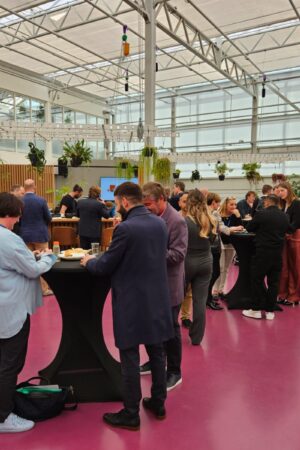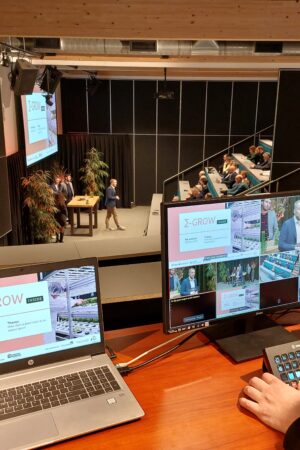Brightlabs, as the name suggests, is a contract research organization where focus is on doing analysis for third parties. The company has four pillars, these are Pharma, Cannabis, Industry and Research (university). Therefore, they work together with the government, Pharmaceutical industry, and worked with Wageningen University as well as other Research institutes. Brightlabs entered the cannabis industry already in 2018 when they received a permit to started working on extracts of cannabis, doing impurity analysis, quickly followed by a complete set of analysis on cannabis; from cannabinoids and terpenes to pesticides and microbiology testing. As for the cannabis department, Brightlabs clients are companies that have a permit for experimental research to work on cannabis research within the Netherlands, for instance, the CfC project.
We asked; what is the difference for Brightlabs between individual clients and a project like the CfC? Bart explained, “When working for customers, often aspects like their goals, research questions, or methods, are not known to Brightlabs, we just report the numbers. Within the CfC project, we have an open understanding of the complete research, unlike with individual research, when we are not aware of the research background. With the CfC we are involved with every cycle and have all information we might need, as we are all part of the team and this project is very transparent. This can be very important for Brightlabs, because thanks to that, we now better understand the impact of the sample handing at the customer side on the results of the analysis. Secondly, this enables us to improve our methodology and develop new methods, as to be able to do that, we need reference materials, which with CfC we have.” Bart mentioned that it was one of the first individual goals of Brightlabs and an important reason for why they joined this consortium.
We got triggered by the statement ‘improving our methods,’ so we wanted to know what improving exactly means in this case. “Indeed, the definition of Improving can vary. One example is extending the number of compounds that are available from one method (looking at terpene analysis, cannabinoid analysis, etc.). Next is accuracy, e.g., how much material would you need for an reliable or representative result? This comes back to what is the spread within a sample? Those are things that we can improve to further upgrade our complete methodology. Lastly, if we are talking about developing new methods, that can be developing new methods for measuring. For example, an analysis to measure the health of the plant and the influence of all the conditions around it by measuring plant sap for instance.”

We wondered if there is some sort of collaboration with the rest of the partners of CfC and Brightlabs; “For our internal method development we do not look at the other team members, but we would like to help the other partners in the CfC in their research projects as well. So, if for instance, Biobest is doing their own experiments, we can help them with the analysis.” Bart claimed and continued the conversation “Cultivation for compounds – where I am emphasizing the word compounds; that means you must do analysis to visualize the results to see the impact of the changes in cultivation to the end result. In this case, the laboratory are the eyes and ears of a project like CfC, as it will provide insights into these compounds. These are the key and end goal of this project. That is why I believe the lab is at the core of what the CfC project want to achieve.”
Next, we wondered whether Brightlabs had some struggles during the CfC. “Arrangements around transport, even within the Netherlands, can be challenging because cannabis is still a licensed opiate, so one must be aware that there are certain protocols that must be followed also with regard to transportation. In the beginning, we took our time to make sure everyone is up to date and know their job. We try to help the people at Vertify to make sure everything is done correctly, even though it is the legal responsibility of the certified facility, in this case Vertify, to transfer the products and make sure it is managed correctly. As Brightlabs we have the experience, and we are still involved in this importance step. For instance, the use of the right packaging for transport is valuable for analysis as well. Therefore, we provided hard air-tied containers, to make sure the quality of the harvest is not damaged in transportation. Also important, from a legislative point, is to weigh the samples when they leave the cultivation facility and when they arrive at our lab. All to make sure nothing goes missing during transport. In the beginning of the CfC, it was a bit of a struggle, having it all go fluently with regards to the transportations. Nevertheless, there is another advantage of having such a long-period project, after transportation was done once or twice, everyone knew what they should be doing and how, so we are not having any struggles with it anymore.”
Concluding the interview, we asked about the decision to join the CfC consortium. The main goals that Brightlabs had when deciding to join CfC were developing their methods, marketing, and gaining knowledge, and experience. “CfC was always meant to be transparent research and Brightlabs believes in it as well. We were always very transparent about our activities, so the two are aligning with their agendas and beliefs. Moreover, we know that all the participants of the CfC are well-known companies and professionals in the industry. Cultivators has a well-known name in cannabis cultivation. So, they are a reliable partner to work with. Looking into the future, we see that the number of possible cannabis clients in the Netherlands will increase soon, therefore, we wanted to make sure we are keeping our knowledge up to date, and at the same time we wanted to show that we are the top cannabis laboratory in the Netherlands, and CfC was just the right way to achieve all these aims we had.”

* Cultivation for Compounds is partly funded by PPS surcharge for research and innovation from the Ministry of Economic affairs and climate.





